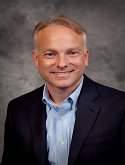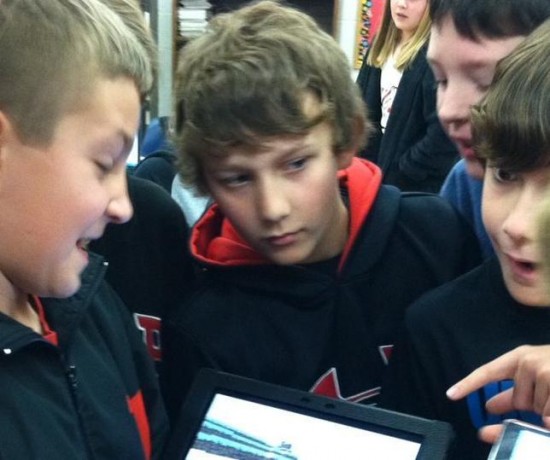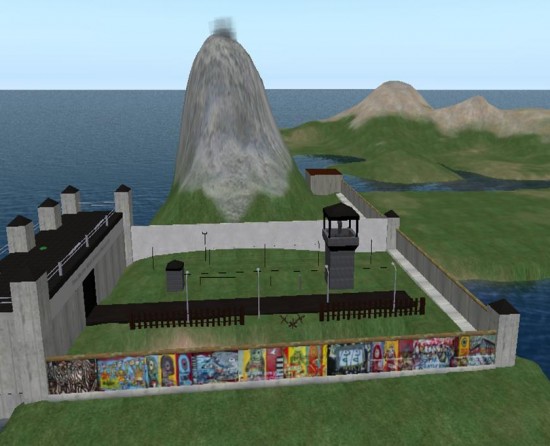You might not think of the state of Georgia as being on the cutting edge of technology — but there’s one school district there that would prove you wrong.
Forsyth County Schools in the Atlanta suburbs has been building up its technology chops for a long time.

“We were the first school system in Georgia to give a notebook computer to every classroom teacher,” Steve Mashburn, the coordinator of online education for the district, told Hypergrid Business. “We were the first school distrct in America to put an interactive white board in every classroom. We were the first school system in the nation to put a Learning Management System in every classroom. We’re one of the first school sytems in the nation to make a commtiement to the Bring Your Own Technology concept.”
That doesn’t mean that people don’t stop and ask questions, he added.
“But we built the capacity to do things like this over a long period of time,” he said.  “We’ve had the advantage of having a very progressive Board of Education. They’ve won awards for being technology oriented. This [OpenSim] is not something that was just out of the world to our district office or to our Board of Education, because we have built so much capacity in technology through the years. A lot of school systems would have some difficulty doing this if they have not gone through the steps we went through.”
“There was a presentation last week to our board, and our board members themselves said they wished they were back in school so they could learn in this manner,” his colleague Tim Clark, the district’s instructional technology specialist, told Hypergrid Business.
Linden roots
It all started — as so many virtual world educational projects do — in Second Life.
“We actually bought an island on the Teen Grid five years ago,” said Mashburn. The teachers had to go through background checks — which cost money — and were limited to the school’s island. The kids, however, could wander at will throughout the Teen Grid.
“We couldn’t have our kids go places we couldn’t see,” Mashburn said. So the island was moved to the Second Life main grid, for staff development.
“We were setting up our first staff development center and a guy flies in with no clothes on and a plastic device, and our boss said, we’re in the Bible Belt, we can’t have that,” Mashburn said. “We couldn’t use it. So we paid for the sim for a year and then closed it down.”
Given all that wasted time, and money, it’s a surprise that the district didn’t give up on virtual worlds altogether.
Instead, Mashburn continued to keep his hand in. He continued to keep an eye on Second Life, waiting for it to become the platform the school needed. He also began exploring OpenSim, creating accounts on InWorldz and OSGrid and other grids.
A year and a half ago, he started to seriously look at OpenSim for education.
“I knew that OpenSim was ready to do what we would require it to do in regards to student safety and those type of concerns,” he said.
The first project he did was for an online endorsement program he taught. In Georgia, teachers can get add-on certificates, called endorsements, for teaching particular subjects. In particular, Georgia has an online teaching endorsement. In the program, teachers could choose what they would do their project, and some chose OpenSim.
That first grid, a four-region Diva Distro, was set up with YourSimSpot a year ago. Then two other local educational institutions began to offer the online endorsement program as well, and Forsyth County, whose staff was already stretched thin, discontinued the course.
But that experiment helped pave the way for a larger OpenSim deployment, with a bigger vendor, and more functionality.
Searching for a new host
With 38,000 students in the district, and about 3,000 teachers, the district went looking for an OpenSim vendor who could handle the challenge of running a big grid, while also offering the features the district needed.
“We had to have somebody who had a history of being a stable company, and a history of success,” Mashburn added. “That was a very important criteria. We couldn’t go with a startup company. We had too much riding on this. And we had to have a company who was willing to tweak the code to do the things that we need done. There are things in an educational environment that are extremely important that aren’t there in a regular OpenSim deployment.”
The search began, he said, with the Hypergrid Business directory of OpenSim hosting companies. “We looked at all of them.”
Some vendors were ruled out early, however.
“The ReactionGrid website is very hard to navigate — it’s very hard to find information on it,” Mashburn said. “You go to their website, and you have no idea what to do. The website did them in for me. I figured if they can’t do a website…Â ”
The company had been early pioneers in offering OpenSim hosting to corporate and educational customers.
But they seem to have lost their commitment to Opensim, Mashburn said, with the recent focus on the Jibe platform.
Another common option for school districts — running OpenSim on their own — wasn’t even on the table.
“It takes specialized skills to do this,” Mashburn said –Â and the district’s IT department was already stretched tight. “They didn’t have the capacity to take on anything else.”
The district eventually settled on Dreamland Metaverse, which has a history of working with corporations and other large clients, and was able to offer some unique features.
For example, students and teacher user accounts could be created in bulk, based on internal directories and managed centrally.
“Most people [in OpenSim] are doing a one or two teacher thing, usually with a technology teacher in a lab,” Mashburn said. “You can manage 30 to 60 students. But when you have 38,000 students, how are you going to manage avatar names, and make sure the names are appropriate? And how are you going to identify the students?”
Using student identification numbers wasn’t an option, he said, because the grid was hosted externally, so Dreamland Metaverse created an algorithm to create a unique avatar name for each student that clearly identified each individual student without disclosing that information. The result would be that avatar first names would be composed of the student’s first initial and their last name, and the avatar last name would be generated randomly and linked at the district to their student IDs.
All the teachers, meanwhile, would have the last name Noble — which stands for New Opportunities for Better Learning Experiences, the name of the grid.
All the user accounts, for the teachers and the students, could then be uploaded as a single file and used to automatically create avatars.
Another batch process was developed to sort students and teachers into appropriate in-world groups.
There are also different permission levels available to different kinds of users. For example, students can build, but they can’t upload textures or objects.
“So if students want a texture, they give it to the teacher, and the teacher uploads it for them,” Mashburn said.
In addition, students can’t hypergrid teleport to other grids, but teachers can.
As a result, the grid is able to have a safe and secure environment for the students, while allowing teachers to network with teachers from other grids, or to travel to events and freebie stores out on the hypergrid.
“I’m so happy with that,” Mashburn said.
Other features include in-world monitoring to track what students are building — and what conversations are taking place. There’s also Vivox voice, the same voice available in Second Life, with lip synching and speaker indications and directionality. Plus, there’s an in-world virtual currency, which kids can use for shopping in the in-world stores, or for setting up their own little virtual businesses.
“We’re really excited about that,” said Mashburn. “Kids are really into making money.”
Dreamland Metaverse also supplied the district with a customized Imprudence viewer, pre-configured to access the grid — and with the default Second Life search turned off.
“Every little problem that comes up, Dreamland has able to resolve it, so we’re very very pleased with the choice that we made,” Mashburn said.
The grid launched earlier this year with 16 regions — four megaregions, each the size of four standard regions. Megaregions are a nice feature for campuses because they have no border crossings — students, teachers and even vehicles can move freely throughout the entire area with no hiccups, as if it was one single large region.
With each region 16 virtual acres in size, the grid is 256 acres in size, or about one square kilometer. For the non-metrically inclined, that’s a square  with each side measuring about two-thirds of a mile.
The price for all this? Â For the bulk avatar uploads, with the Vivox voice, with the different ability levels for different users, with the groups, with the virtual currency, with the ability to save local backups of entire regions with a click?
Around $360 a month.
“Which is crazy,” Mashburn said. “That’s just crazy.”
(You can see the price list for Dreamland Metaverse here, with regions ranging from $30 to $90 a month each — which is very typical of OpenSim hosting prices. Many hosting providers also offer educational discounts, so don’t forget to ask.)
It’s no wonder the district plans to expand the grid.

“We even had a principal say she’s willing to buy her own school space because there was so much demand at her school,” Clark said. “She can have her own region for around $50 a month.”
The principal even came up with a creative way to help pay for it, by finding local sponsors, he added. “She can have a restaurant right in her own region where students can buy and sell and learn about local marketing and it happens to have the name of the sponsor’s business on the side of it. That’s really huge — that a principal would go from no experience at all, to thinking about it in a merchandising way to be able to provide this to her students.”
After a series of presentations to school principals and information sessions for teachers, the first group of teachers was ready to begin their training.
The students refuse to leave
The teacher training sessions began in February, and the first group of 47 teachers have already graduated — out of about 3,000 teachers total.
“It’s a start,” Mashburn said. “And eventually we know it’s going to grow and grow.”
The next round of training will be for the instructional technology specialists and media specialists at each of the schools, added Clark, as well as the school administrators, about 70 people total.

Meanwhile, the first set of students is already in-world.
“We got a fifth grade class that’s driving us nuts because we can’t get them out,” Mashburn said.
That’s because students are accessing the grid from home, Clark explained, with parental permission.
“So we’ve had to set up times, because we wanted an adult there when the students are there,” he said. That means, late hours for the adults scheduled to keep an eye on things.
“We’ve also had some other experiences, like a land grab, building in places where we didn’t want them to build,” Clark said. “Students have had to resolve issues like building on top of someone else’s construction — it’s gone way beyond anything they could have had in a face-to-face classroom.”
The first week the grid was up and running, Mashburn logged in at 1 a.m. at night to do some work.
“And there’s a fifth grader in there,” he said. “That’s the appeal it has for kids.”
The grid was running a little slowly last week, Clark recalled. “We went in to see what happened, and in one region, students had run out of land to build on, so they built another layer of land in the sky, and were filling it up with new construction.”
The kids have been getting creative.
The first lesson set in the OpenSim environment was with a recreation of the Cold War’s Berlin Wall. Students had to work with team members to figure out ways to escape across the wall.
“They’ve been building everything from balloons to ramps to airplanes,” Mashburn said. “One boy built a jet plane — I don’t know where he would find the material to do that in East Germany, but that was his solution.”
There was also a hidden underground sewage tunnel accessible via a manhole, which some kids discovered.
“Just being able to experience the reality of the graffiti on the West Berlin side, and seeing the contrast on the East Berlin side, those kinds of things couldn’t be replicated in another way that made sense to the students,” said Clark. “It’s like a living museum for them.”

That same class is now studying volcanoes and the theory of how land changes over time.
“We’ve built a volcano for them,” Mashburn said.
Another fifth grade class is doing an environmental science course, and will be playing the roles of environmental scientists who come into a town and  have to figure out why the fish in the river are dying.
And a sixth grade Spanish class will be working together with an eighth grade Spanish class in another school, Mashburn added. “That’s something which would be very difficult in real life because of transportation issues. They’ll have an outdoor market and the kids are going to making things for sale and buying things — and talking in Spanish.”
When possible, environments are created with an eye towards eventual re-use.
“We we don’t have the capacity to do everything that’s possible — even though we tell the teachers that anything is possible in OpenSim,” said Mashburn. “So one of the thigns we’re trying to do is get people to share common learning spaces. For example, we made a county courthouse and this county courthouse can be used to do a reenactment of Twelve Angry Men, or the court scene from To Kill a Mockingbird, or any type of court proceedings and mock trials. We’re also going to be using it as a place to vote for the presidential election next year.”
Finding content
A year ago — heck, even a few months ago — setting up a grid like this would have been a massive undertaking. Mashburn and his team would have had to create all the avatars, bring in all the textures, build all the buildings, create all the landscaping from scratch.
Not any more.
The NOBLE grid is built around a small town center, with a store where students can buy anything they need. But that required very little work at all, thanks to the efforts of Linda Kellie and other designers who have been making their content available under Creative Commons licenses.
Linda Kellie in particular has more than a dozen OAR files — entire saved regions — available on her website, ready to be uploaded with a single click to a new grid. There are are indoor and outdoor shopping malls, mountain retreats and beach resorts, fantasy landscapes and a Wild West town, all produced to high standards — Linda Kellie was a professional content designer in Second Life before she decided that she gets more satisfaction making things just for fun and giving them away.
And she’s not alone. There is a wide variety of free content now available for OpenSim, including more than 60 ready-to-go full region OAR files, many with an educational focus, and it’s growing quickly.
“We’re using everything we can find,” said Mashburn. “The Linda Kellie stuff. All the links you have on your site.”
The NOBLE grid’s town center, for example, was originally a Linda Kellie OAR file, but was then modified and rearranged to fit the needs of the district.
But the content sharing isn’t just a one-way street.
Mashburn said that he plans to make his builds available to other districts, in the form of ready-to-use OAR files.
Spreading the joy
Other educational institutions have begun reading out to Forsyth to talk about joint projects.
“We already had several school districts interested in partnering,” said Mashburn. “There’s a possiblity that another school district will be a partner with us in the NOBLE world next year, and our regional school district association is interested in pushing this out to the school districts they serve.”
Two local colleges have reached out about the possibility of working together — specifically, having their students act as student teachers on the NOBLE grid.
“That’s the kind of relationship that would be of mutual benefit,” Mashburn said. “And it gives us a pool of teachers with a background in virtual worlds.”
And the University of Louisiana has offered to donate their STEM educational materials — that’s Science, Technology, Engineering, and Mathematics — with everything packaged up in OAR files.
Up next
Mashburn said he’s got 24 OpenSim learning projects in various stages of development. Then, in the summer, there will be more staff developments courses for teachers. “We’ve got a lot going on.”
And virtual learning isn’t about simply duplicating the traditional learning environment in a virtual classroom. Virtual environments are going to transform learning, Clark said.
“We have to change education,” Mashburn added. “What we’ve doe in the past is no longer effective — if it ever was. The kids we have now have grown up in the virtual world.”
“And they don’t want to be consumers,” said Clark. “They want to be producers.”
- OSgrid back online after extended maintenance - April 16, 2025
- Analysts predict drop in headset sales this year - March 25, 2025
- OSgrid enters immediate long-term maintenance - March 5, 2025
